Quote di indagine
From LimeSurvey Manual
Introduzione
Una quota viene utilizzata per impostare un limite alle risposte di gruppi definiti di persone in un sondaggio attivo. Alcuni attributi comuni utilizzati nella definizione delle quote sono sesso, età, razza, provincia/stato, ecc. scheda .
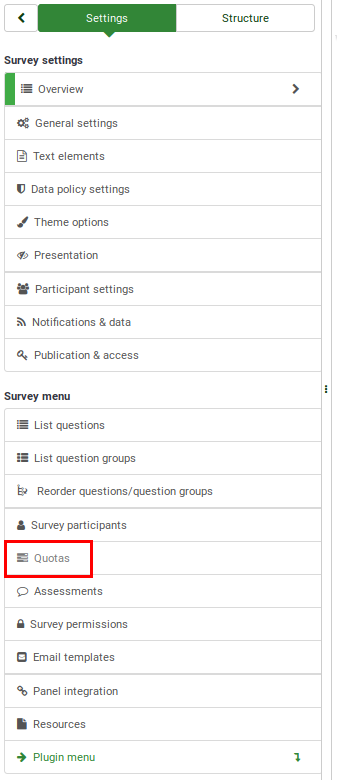
Come funzionano le quote?
Per capire come funziona il sistema di quote di LimeSurvey, pensa a un sondaggio che contiene una domanda "Sì o No" e una domanda Array, ciascuna delle quali appartiene a due diversi gruppi di domande. Hai impostato una quota per questo sondaggio che contiene una restrizione di 20 utenti che hanno risposto "Sì" a questa domanda. La quota verrà controllata ogni volta che qualcuno risponde "Sì" a quella domanda.
A seconda del formato del tuo sondaggio (come le domande vengono visualizzate ai tuoi partecipanti), il controllo avviene quando invii:
- l'intero sondaggio risponde in una volta sola: Se il formato del sondaggio è tutto in uno, le domande (indipendentemente dal gruppo di domande a cui appartengono) verranno visualizzate sulla stessa pagina. Pertanto, l'utente deve fare clic sul pulsante di invio per attivare il controllo del limite di quota;
- le risposte a un gruppo di domande: Se il formato del sondaggio è gruppo per gruppo, la quota viene attivata quando il partecipante al sondaggio ha risposto a tutte le domande che appartengono al gruppo di domande in cui la risposta che contiene il controllo del sistema di quote in cui si trova. Pertanto, la quota può essere attivata prima della fine del sondaggio se, ad esempio, il gruppo di domande si trova all'inizio del sondaggio.
- la risposta a una domanda: Se il formato del sondaggio è domanda per domanda, ogni domanda verrà visualizzata separatamente, a ciascuna di esse verrà assegnata una pagina. In questo caso, se selezioni la risposta a cui è applicata la quota, il sistema delle quote verrà attivato automaticamente dopo aver fatto clic sul pulsante Avanti/Invia.
Se si sceglie "No", il sistema delle quote non viene attivato. Pertanto, il sondaggio non impedirà a nessuno di rispondere al resto delle domande, se non diversamente specificato.
Per impostare un limite al numero di risposte "No", è necessario aggiungere una quota aggiuntiva, restringendo il numero di partecipanti che scelgono "No".
Uso di più risposte e quote
Esempio: vuoi condurre un sondaggio in cui vuoi limitarlo a 25 partecipanti di sesso maschile e 30 di sesso femminile. In questo caso dovrai applicare due limiti di quota: uno sui maschi e uno sulle femmine. Questo ti darà un massimo di 25 maschi che possono completare il sondaggio e un massimo di 30 femmine che possono completare il sondaggio..
Supponiamo ora di volere 50 risposte dai maschi e 50 risposte dalle femmine. Tieni presente che ogni risposta che attiva la quota deve essere inserita nella propria casella della quota. Sommando le due risposte nella stessa casella si otterranno 50 risposte, indipendentemente dalla distribuzione di genere degli intervistati (es. la distribuzione può essere 40 maschi e 10 femmine, oppure 20 maschi e 30 femmine, e così via). Continua a leggere questa pagina wiki e consulta la sottosezione examples per avere un'idea dell'utilizzo del sistema delle quote.
Attivazione del sistema di quote mentre la tabella delle risposte al sondaggio non è vuota
Tieni presente che non è necessario aggiungere necessariamente un sistema di quote prima di attivare il tuo sondaggio. Se decidi di attivare il sistema delle quote in un secondo momento, inizierà a controllare la tabella delle risposte al sondaggio e cercherà le voci contrassegnate come complete. Quindi, controlla per determinare se la condizione della quota è stata soddisfatta o meno. Se è stato soddisfatto, le successive risposte/voci al sondaggio ricevute saranno contrassegnate come incomplete.
Ad esempio, se hai raccolto in precedenza 1000 risposte da donne e hai introdotto dopo un paio di settimane il limite di quota di 800 per le donne, le successive risposte che riceverai dalle donne saranno contrassegnate come incomplete. Le altre 200 risposte appariranno nella tabella delle risposte al sondaggio come complete perché la quota è stata applicata dopo che le risposte sono state raccolte.
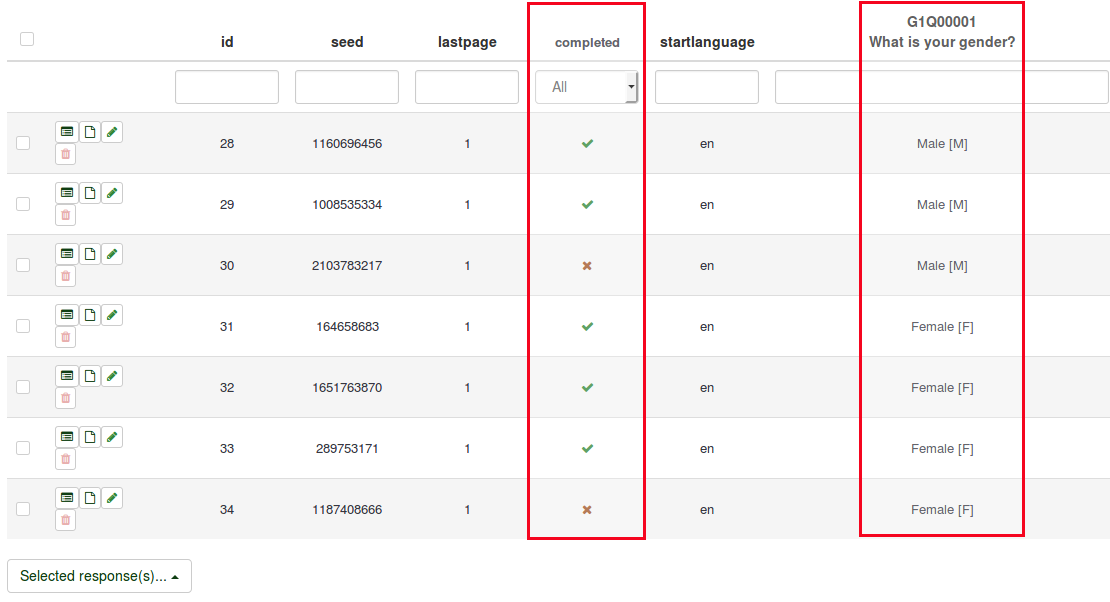
Il sistema delle quote non memorizza alcuna risposta e non registra il numero delle risposte al sondaggio inviate! Pensalo come un filtro applicato alla tabella delle risposte al sondaggio. Fondamentalmente, esamina la colonna completata e quelle colonne di domande che contengono le risposte a cui sono applicate una o più quote.
Tipi di domande supportati
Il sistema delle quote può essere applicato al momento solo ai seguenti tipi di domande:
- Sesso
- Scelta multipla
- Array - Scelta a 5 punti
- Array - Scelta a 10 punti
- Cambio lingua
- Sì/No
- Elenco (radio)
- Elenco (elenco a discesa)
- Elenco con commenti
- Equazione
Pannello quote sondaggio
Dopo aver fatto clic sulla scheda Quote del sondaggio dal menu del sondaggio, verrà visualizzata la seguente pagina:

Per visualizzare l'insieme completo di opzioni di questo pannello, aggiungi una quota di sondaggio. Quindi, la pagina della quota del sondaggio sarà simile alla seguente:

Sono disponibili le seguenti opzioni:
- Aggiungi nuova quota: Situato nella parte in basso a destra della tabella delle quote del sondaggio, consente agli utenti di aggiungere nuove quote . Una volta che le quote sono visualizzate sulla tabella, puoi iniziare a implementarle in determinate risposte a domande/sottodomande.
- Aggiungi una risposta: Prima di aggiungere una risposta, è necessario aggiungere una quota in cui verranno memorizzate le risposte. Verrà applicato il limite di quota solo alle risposte visualizzate nella casella della quota.
- Modifica quota: fai clic sulla matita verde situata sotto la colonna Azione della tabella delle quote del sondaggio per modificare i campi di una quota
- Elimina quota: fai clic sul pulsante rosso del cestino situato sotto la colonna Azione della tabella delle quote del sondaggio per eliminare la rispettiva voce di quota;
- Convalida della quota: Fare clic sull'ultimo pulsante situato sotto la colonna Azione della tabella delle quote del sondaggio per controllare rapidamente il messaggio di quota visualizzato dagli intervistati , l'URL (e/o una sua breve descrizione) dove verranno reindirizzati.
- Rapporto CSV rapido: Esporta un riepilogo delle quote sotto forma di tabella CSV delimitata da virgole.
- Quote selezionate...: Funziona come un aggregatore. Selezionare più quote e utilizzare questo pulsante per applicare una delle azioni descritte di seguito al gruppo di quote selezionato.
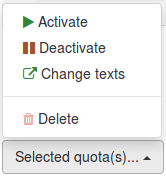
- Attiva: Usa questo pulsante per attivare una quota. Quelli attivi hanno il nome della quota, l'azione e l'URL scritti in carattere bianco su sfondo verde.

- Disattiva: Usa questo pulsante per disattivare una quota. Quelli disattivati hanno il nome della quota, l'azione e l'URL scritti in carattere nero su sfondo grigio.

- Cambia testi: Utilizza questo pulsante per modificare rapidamente il messaggio di quota, l'URL e la descrizione dell'URL di un gruppo di quote. È possibile utilizzare questa funzione per reindirizzare gli intervistati a un determinato collegamento una volta soddisfatte diverse condizioni di quota.
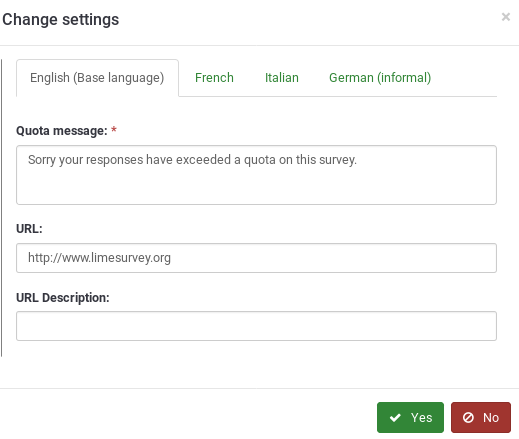
- Elimina: Se desideri eliminare un gruppo di quote con pochi clic, seleziona quelle che desideri eliminare, fai clic sul pulsante delle quote selezionate e seleziona l'opzione Elimina .
Add new quota
For a fully working quota you must first "add a quota", and then "add answers" to that quota.
Once you click the Add new quota button, the following page will be displayed:

The following options are available:
- Quota Name: The name of the quota that will be displayed on the survey quotas table. It should describe the quota it will represent.
- Quota Limit: The maximum number of completed surveys that will be stored in the responses table and marked as complete. See above the wiki section on how do quotas work to better understand the mechanism employed by LimeSurvey.
- Quota Action: If the quota is triggered, then one of two actions will happen:
- Terminate survey: This action immediately terminates and closes the survey.
- Allow user to modify his last answers before terminate survey: Useful action when you want your participants to choose different options. In this way, you can force some of them choose another solution or option. For example, when incentives are offered, you can use a quota on each option so that not everyone chooses the same incentive.
- Autoload URL: This tells LimeSurvey to automatically redirect the participant to the URL when the quota action occurs.
- Quota Message: Write the text you want to be displayed to participants if the quota action is triggered. The message will be displayed if the Autoload URL is disabled.
- URL: The URL displayed to survey participants after the quota action is triggered. The users can also be automatically redirected to this URL if "Autoload URL" is enabled. You can use URL fields in this section.
- URL Description: A short URL description can be added in order to show to the other survey administrators the purpose of the URL for example.
Add an answer
Once the quota has been created, you can start adding answers. To add answers, access the Survey quotas panel. Look into the survey quotas table and select the Add answer option from the quota box that you want to add the respective answer to.
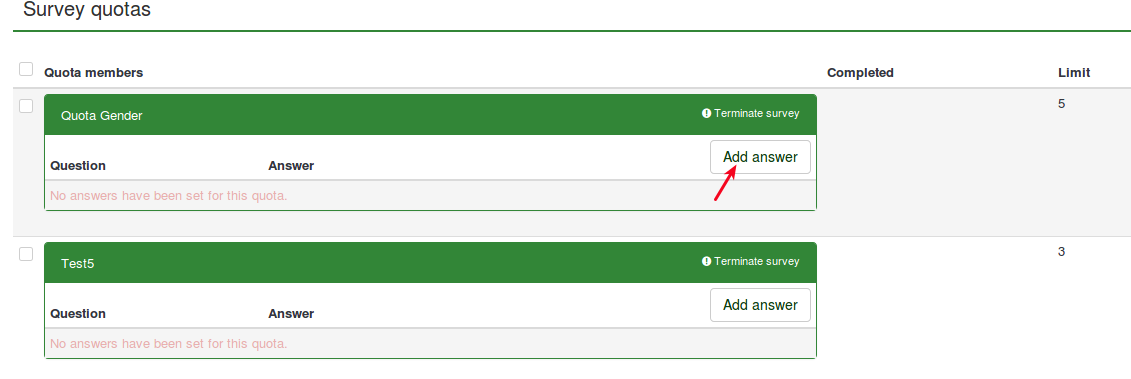
A new page will be displayed asking you to select the question the quota will be applied to.
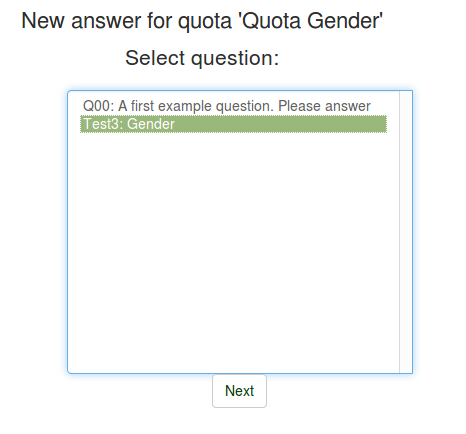
Click Next. The answers of the question you selected one step before will be displayed. Now, you have to choose which answer you want the quota to be applied to.
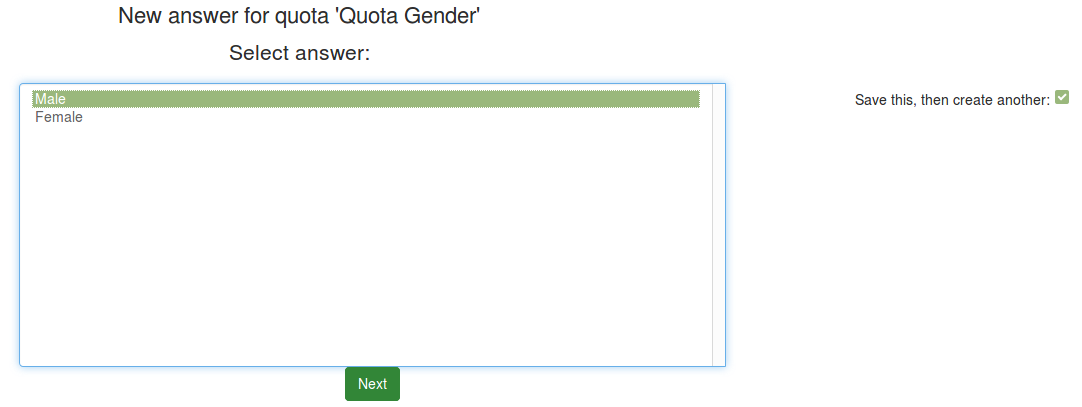
In this example, the "Male" answer will have the quota applied to it. Whenever participants choose this option, the quota system registers the answer. Once the quota limit is reached, the stored survey answers will be saved in the survey responses table, but it will be marked 'incomplete.
Quick CSV report
The quick CSV report function is used to export the survey quotas table in a comma-delimited CSV file. It includes the following fields:
- Quota name: The name of the quotas;
- Limit: If the quota is active, it represents the maximum number of survey responses that can be marked as complete in the survey responses table;
- Completed: The number of survey answers marked as complete in the survey responses table. Please note that an answer is marked as incomplete if the quota is triggered.
- Remaining: The number of answers that can still be collected in the survey responses table and marked as complete there.
Quota and tokens
When the response is not submitted
When tokens are used in a survey and a participant is screened out due to a quota, then the respective token entry from the survey responses table is marked with the letter "Q" in the completed column from the survey responses table. The token is invalidated in this way and the survey participant cannot restart the survey.
When response is submitted
With update responses with one token allowed : a participant can open an already submitted response.
After being submitted, when a response is being edited, quotas are not checked at all. Then a participant can update own response and set a value out of quota.
Examples
The following examples are used to better explain the role of quotas and their usage within the LimeSurvey environment. Before viewing the following examples, please take into account that:
- Answers added in the same quota are summed up. For example, if answers A and B from the available responses of a survey question are added to quota Q1, the quota limit sums up the number of users who pick up A and B as their answers. Therefore, there is a high probability that the distribution of A and B answers will be uneven (dependent on the characteristics or preferences of your respondents).
- Answers added in different quotas act as if there is a logical operator "AND" between them. Let's suppose that A is added to Q1 and B to Q2. If A is chosen and Q1 is reached, then respondents won't get their answers marked complete in the survey responses table. However, the survey participants that choose B are still allowed to continue as long as Q2 is not reached. Once it is reached, participants who further choose A or B as answers to that specific question will have their answers marked incomplete in the survey responses table.
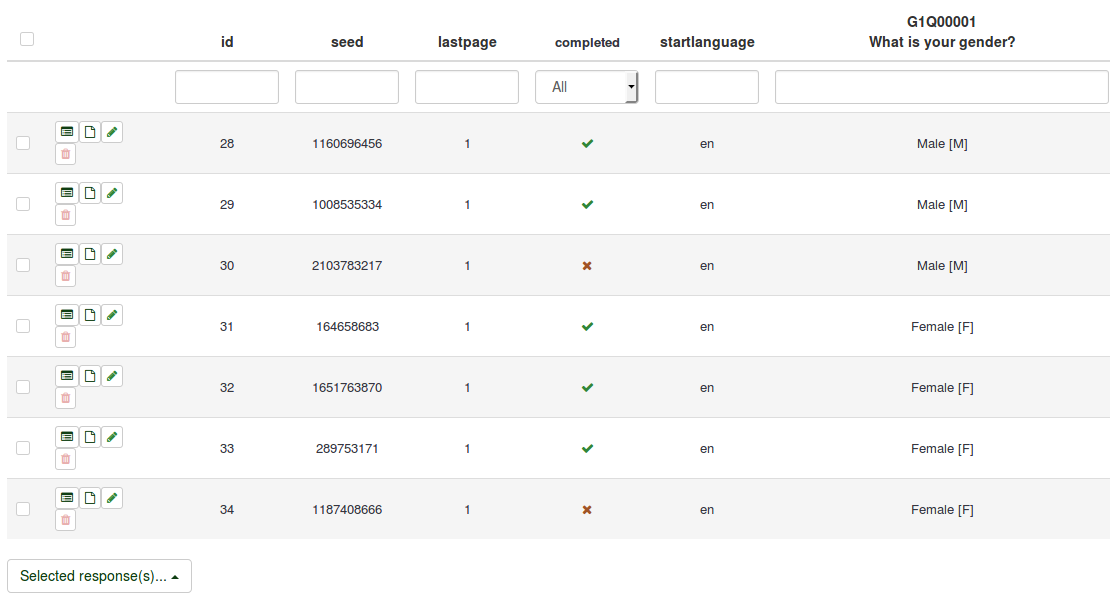
Adding more answers to different quotas
Let's assume that you are doing a survey about LimeSurvey and you would like to receive feedback from your participants. You would like to receive 1000 answers from students (PhD student, graduate, undergraduate) and another 1000 from non-students (unemployed persons, full/part-time working persons or other). In order to do this, create two quotas: Students quota and Non-students quota.

Now, start adding answers to each quota box following the steps described above in the wiki section. The quota boxes should look like this:

By using this method, you limit the number of responses you receive from the two defined groups: students and non-student groups. Now, activate the survey and start testing the quotas. If you first reach 1000 answers from the non-students group, the next answers you receive from this category will be marked as 'incomplete in the survey responses table. Only answers that come from the students group will still be accepted. Once it also reaches 1000, no more answers will be registered as complete in the survey responses table.
Adding a URL link
To add a URL link to a quota, please continue reading the URL fields wiki section.
Using of equation question for quota in other question type
You can use Equation Question to set a value to supported question types and assignment operator.
The 2 question can be hidden, quota is checked if all question are hidden or when one question is in submitted page.
For example , to set a quota to a text question (user write ok or not) on a Y/N question: {QuotaQuestion=if(strtolower(Q00.NAOK) == 'ok', 'Y', 'N')
You can import and activate this sample survey File:Limesurvey survey quotaEquationAndOptOut.zip (remember to unzip the file and activate the survey).
Like using an equation to set a value to an answer, quota for default values are checked if a question is hidden. This allows you to set a maximum number of response in a specific survey. You put a quota on the default answer in a hidden question and put this question in a simple group.
You can import and activate this sample survey File:Quota by default value sample survey.zip (remember to unzip the file and activate the survey).
